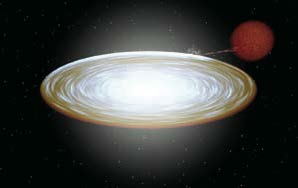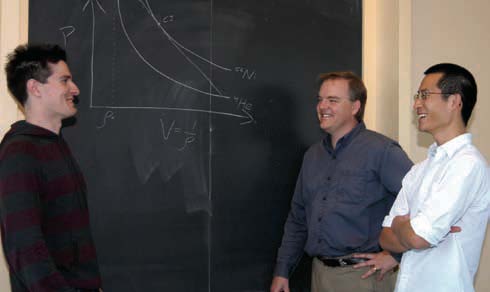 Artist’s rendering of binary where a .Ia explosion can occur
Artist’s rendering of binary where a .Ia explosion can occur
Credit: Robert I. Hynes, LSU
An explosion — observable in theory, but never seen on the night sky – emerged a little over two years ago from calculations carried out by a team of astrophysicists, including KITP permanent member Lars Bildsten and postdoctoral fellow Nevin Weinberg, as well as UCSB physics graduate student Ken Shen and Bildsten’s long-time Dutch collaborator Gijs Nelemans of Radboud University in Nijmegen. Those calculations enabled the team to predict the existence, in distant galaxies, of a new kind of exploding star or “supernova” that would — when detected — be fainter than most observed supernovae, and would rise and fall in brightness in only a few weeks.
“As we talked about our work over the last two years, most astronomers in the audience reminded us that they had never seen such an event,” said Bildsten. “We told them to keep looking!"
In the Nov. 5, 2009, “Express” edition of Science (the journal’s online vehicle for expediting publication of particularly newsworthy developments), a UC Berkeley-based team, headed by postdoctoral fellow Dovi Poznanski, reported detection of a faint and fast event in a distant galaxy that likely represents the phenomenon whose existence the Bildsten group predicted.
Most stars end their lives sedately by collapsing into white dwarfs, with masses equivalent to the Sun’s packed into a sphere with a radius akin to the Earth’s. Though very dense, these objects (made of either a carbon-oxygen mixture or nearly pure helium) cool to temperatures so low that fusion reactions can no longer occur.
But in rare instances, two of these dwarf objects orbit each other so closely (orbiting every few minutes) that the helium from the lighter of the two gets pulled off by tidal forces and accumulates on the more massive carbon-oxygen white dwarf (as depicted above). This rare occurrence sets up conditions for explosive thermonuclear ignition and the consequent complete ejection of the accumulated helium ocean from the more massive dwarf. The plethora of unusual radioactive elements made in the rapid fusion of atoms leads to a bright light show from the freshly synthesized matter that lasts but a week or so.
Bright events from complete thermonuclear explosions of white dwarfs have been known for many decades, and are referred to as Type Ia supernovae. They are brighter than a whole galaxy for more than a month and are quite useful in cosmological studies.
 Bildsten (center) discussing the physics of detonations with UCSB graduate students Kevin Moore (l.) and Ken Shen
Bildsten (center) discussing the physics of detonations with UCSB graduate students Kevin Moore (l.) and Ken Shen
Photo by Nell Campbell
The events predicted by the Bildsten team are only one-tenth as bright for one-tenth the time in comparison to Type Ia supernovae.
That fractional luminosity and its fractional duration led Chris Stubbs at Harvard to the witty christening of such events as “.Ia (‘point-one-a’) supernovae.”
The Bildsten group published their prediction in an article that appeared in the June 2007 issue of Astrophysical Journal Letters. Bildsten confesses that he worried whether the journal’s editors would permit the naming — however clever — of an astronomical event yet to be detected, but they did. And, said Bildsten, “The name has stuck! Marketing is a big part of success for any idea, even in science.”
When Bildsten was organizing the August 2009 KITP conference on “Stellar Death and Supernovae,” he received an email from Poznanski, the lead author of the recent Science article, asking to give a talk at the KITP. Said Bildsten, “Dovi was vague about his intended subject. All he told me was that it was new and exciting, so I said, ‘Sure!’"
“By the time the conference occurred,” said Bildsten, “Dovi was willing openly to discuss his discovery of a unique faint and fast supernova and to begin the interpretation of the event as a ‘.Ia’ supernova.” Bildsten recalls his excitement, “With the sky the limit, the observers are usually ahead of theory, so I am really happy that we were able to make a prediction that allowed for a rapid interpretation of a new phenomenon. Even though the supernova was observed in 2002, it took Dovi’s keen eye to appreciate its import and relevance.”
Despite the apparent success, more puzzles remain, and Bildsten and his collaborators, especially UCSB graduate students Ken Shen and Kevin Moore, are actively working on them. These include deep theoretical issues of how helium explodes, and whether or not the underlying white dwarf remains behind. Said Shen, “We were always interested in these new possibilities, but now we have a real motivation. Where there is one, there are many, so things are going to get exciting!”
